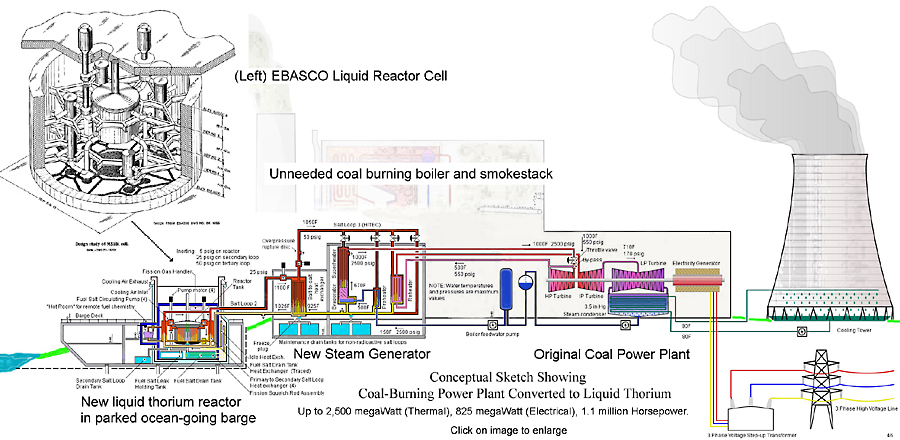________________________________________________________________
coal2thorium.com 

coal2thorium.com 

http://carma.org/plant/detail/44204 CARMA report for Taichung's
2007 Carbon Emissions:
Global Rank: 1, Short Tons CO2
39,700,000, MegaWatt-hour
39,200,00, CO2
Intensity 2.022.
MegaWatt-hour Energy: Annual megawatt-hours of electricity produced. CO2
Intensity: Pounds of CO2
emitted per megawatt-hour of electricity produced.
As an engineer, my heart
goes out to them.
Plant
City
Country Annual Tons of CO2
TAICHUNG Lung-Ching Township Taiwan (China)
41,300,000
- That's 41 MILLION Tons of CO2, folks!
That's like taking 13 MILLION cars off the world's roads.
Google Finance page for Taiwan Power
http://www.google.com/finance?cid=14357378
Clicking on “more” takes
you to this Hoover’s report. Note the various tabs above the text.
http://www.hoovers.com/company/Taiwan_Power_Company/hkfjyi-1-1njdap.html
________________________________________________________________
Steam Compatibility
Why
the author thinks the Model "T" reactor has the "Right Stuff" to replace coal.
Using the world's largest
CO2
source, TAICHUNG coal power plant, as an example.
http://www.gepower.com/prod_serv/serv_for/gas_steam_turbines/en/cmus/cmus_ist/index.htm
________________________________________________________________
Beyond, and in front of the turbine gallery, and running the length of
the gallery, is the electrical transmission switchgear yard. Beyond the
stacks to the left are the coal piles in the coal yard with coal conveyors
reaching into the coal piles. In the distance, on the little
harbor's water and to the
left, are a couple of Panamax-size ocean going coal barges. This enables coal
purchases from virtually anywhere in the world.
(Google Image oblique view looking North East.) Notice visitor's entrance at end of turbine gallery in upper right corner. Upon entering those doors, the view down the turbine gallery must be mind-blowing. Electrical switchyard extreme right, turbine-generator gallery running length of facility, individual boiler houses branching off, coal conveyors coming from coal yard on extreme left. Shared stacks, individual emissions precipitators and associated ductwork quite visible along center.
________________________________________________________________
The Plan
The plan:
Replace Taichung's eight
coal-burning boilers with eight Model "T"
The
many
advantages to cleaning up an existing power plant
rather than building an entirely new power plant.

COAL BURNING Power Plant
The electricity generator's turbine (red) is disconnected from the
coal burning boiler (center, lifted, faded), then reconnected to the nuclear boiler.

1. Water pre-heater, 2. A steam superheater - reheater, 3. A steam evaporator, 4. A steam pre-heater,
all shown here as a single heat exchanger.
Why
Taichung?
It is important to begin with the world's biggest CO2 emitter.
Replacing the coal burning boilers
The new nuclear boiler row would have individual primary control rooms and staff for each reactor along with reactor pair-shared service buildings. The steam generators would be located next to the reactors, in the direction of their boiler houses. (See BN-600 drawing, below.)
Taichung units 5,6,7,8: Four 550MW Coal/Oil units.
Feb 20, 1992: "Babcock & Wilcox (B&W) was awarded the contract for the design,
supply, manufacture, and delivery of four pulverized coal and oil fired boilers
including the auxiliary equipment and their Selective Catalytic Reduction (SCR)
systems. Each boiler is a natural circulation, balanced draft, sub-critical
pressure boiler with single stage reheat capable of generating 508.3 kg/sec
(4,034,000 lb/hr) steam at 174 bar (2,524 psig)."
Cautionary Note: The steam from the Model "T" reactor boilers would have to be identical in both quality and quantity to the steam being produced by existing coal-burning boilers. A cautionary note is that the "two additional 550MW coal-fired units built on adjacent land reclaimed by depositing ash. The two subcritical pressure units (numbers 9 and 10) are the same as the eight previously installed units." Only 8 units are shown on the Google image.
Naked Nukes. These would be just the bare reactors and their steam generators. Nothing else would be from nuclear-land. The power plant would be completely re-used - up to the point they could run on coal again if they wished - merely by re-setting the turbine's steam selector valves. This means the cost will be some fraction of a full nuclear power plant and probably much less than the cost of adding "Clean Coal's" Carbon Capture and Sequestration - if it ever gets invented and developed. And, unlike the anticipated 30% loss of power and increase in coal burning, a nuclear repowered plant would run just as powerfully as it did before - and with fuel costs being nuclear rather than coal.
While there is the usual containment, all equipment and the primary control room should be installed at a level sufficiently above grade higher than any anticipated storm surge. Many power plants all around the world are built on sea shores to take advantage of the cooling water so sea-size storms are a common hazard for power plants. See: Water Table Concern
________________________________________________________________
Construction
Repowering a supersized coal burner to nuclear. If the unit to be repowered was 550 MVA, a 1,000 MVA nuclear boiler would make a second, 450 MVA turbogenerator possible. The new equipment: A Model "T" MSR reactor mounted on a containment barge and unpressurized heat transfer salt heated steam generators.
How
a supersized coal burning power plant can be repowered with a nuclear reactor:
A typical coal burning power plant (above) has it's coal equipment disconnected
(above, shown lifted away and faded) and a new Model "T" nuclear reactor is
added - in a reinforced concrete containment building (blue).